Review: Coolpad Canvas for Cricket Wireless
Jul 27, 2017, 3:00 PM by Eric M. Zeman
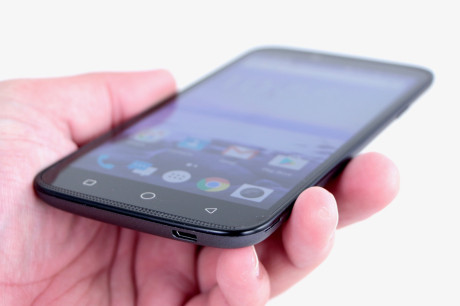
The Canvas from Coolpad is one of the least expensive handsets in Cricket's lineup of Android smartphone. It boasts a large display, 8-megapixel camera, and Snapdragon processor. If you need a low-cost point of entry, the Canvas is a respectable option. Here is Phone Scoop's in-depth review.
Is It Your Type?
The Coolpad Canvas hopes to tempt those seeking a big screen on the cheap. This really-low-cost Android handset is a starter device for Cricket Wireless that marries a large display with a simple design. It's a good candidate for young or novice users.
Body
The Canvas from Coolpad rocks an old-school design. It reminds me a lot of the entry-level Android smartphones we saw 6 or 7 years ago from the likes of Samsung, LG, and ZTE. Coolpad took a straightforward approach in crafting its curves and corners, leaving the Canvas with a generic and somewhat forgettable look.
The phone has a large piece of glass on front that is fitted into a plastic frame. A removable shell forms the back and side edges of the Canvas and wraps around to the front. The frame is thicker at the top and bottom edges, where it has the faux look of stereo speakers thanks to the grille-type pattern carved into the plastic. (The phone does not have stereo speakers.) The entire front is black, while the sides and rear are a silvery gray.
Thanks in part to the 5.5-inch display, the Canvas is rather big. It measures 6 inches tall and 3 inches wide, or about the same size as the flagship Moto Z2 Force. It looks and feels thicker than its 0.33-inch thickness (8.4mm). Most people will likely be more comfortable using the phone with two hands rather than one. My thumb cannot stretch to reach the upper portions of the screen unless I adjust my grip on the phone. It may be too big for those with the smallest hands (and kids will definitely need two hands). I didn't have any trouble putting the Canvas into my pockets, though it may not fit in the tightest jeans.
Apart from the glass on front, the Canvas is all plastic. The phone doesn't feel cheap, but you'll know it's no flagship. Coolpad tucked the glass into the plastic frame tightly and I didn't see any gaps or uneven seams. The rear shell snaps onto the chassis snugly; it stops just short of feeling flimsy when removed. Given the low cost of the Canvas, I think most people will be pleased with the fit and finish.
The front of the phone is very black. The screen itself nearly matches the darkness of the surrounding bezel. I wish the bezels were a bit thinner, particularly above and below the screen. On the phone's forehead you can just barely make out the front camera lens and sensor array. Coolpad lined the Canvas' chin with capacitive buttons for controlling the Android operating system. These keys are flush with the surface and light up when the phone is being used. It can be hard to find them by feel. Oddly, Coolpad opted to stick the app-switcher button on the left and the back button on the right. This is the opposite of most Android phones other than those made by Samsung.
You'll find the volume toggle on the left edge of the Canvas. It's perched high up, close to the top. It's a single, long bar with an acceptable profile and smooth finish. Travel and feedback aren't very satisfying. I'll levy the same criticisms at the screen lock button, which is on the phone's right edge. It's a lot smaller than the volume toggle, has the same smooth texture, and is equally difficult to find sometimes. Travel and feedback could be better. I don't like the way my thumb slides off the button along the side edge, as it loosens my grip on the phone. Both the toggle and screen lock button need to be 1mm closer to the front of the phone.
Coolpad included a 3.5mm headset jack and it's located on top. The microUSB port is off-center on the phone's bottom edge.
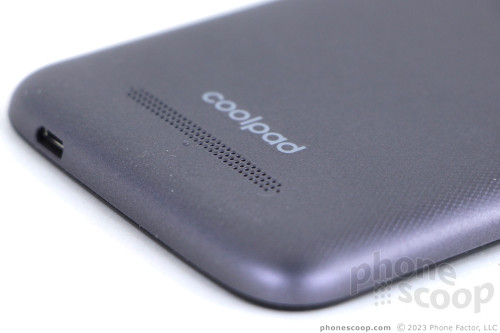
As noted earlier, the rear shell encompasses all four side edges as well as the entire back of the phone. It has microscopic triangles arranged in a diamond pattern to give it some texture. The triangles fade out near the rear corners and turn into smooth plastic along the sides. I rather like this design treatment. Some may not appreciate that the camera protrudes a bit from the surface of the phone. A single LED flash sits below the camera followed by the Cricket logo, which is painted and etched into the plastic. A series of small, circular holes near the bottom signal the location of the speakerphone. Coolpad's logo is just above the speaker.
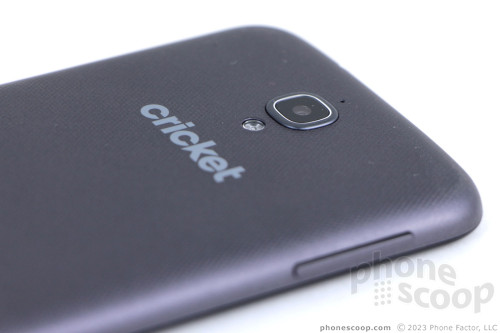
A small notch in one corner helps provide the needed leverage so you can pop off the rear shell. It comes off easily, but requires a bit of thumb work to snap back into place properly. With the cover removed you have access to the swappable battery. It's large in size, if not capacity. The SIM and microSD slots are stacked on top of one another. You'll need to remove the battery to access the SIM card, but you can swap memory cards with the battery in place.
The Coolpad Canvas isn't the trendiest handset ever assembled, and yet it instills a sense of confidence when used. The hardware easily exceeds the value of its price point.
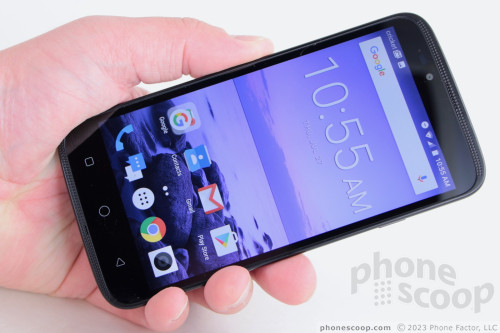
Screen
Coolpad gave the Canvas a 5.5-inch, 720p HD display. The screen is an IPS LCD panel. The display's size and resolution aren't the best match. The lower number of pixels means some on-screen items have hazy or ill-defined edges. You can't quite see individual pixels. I wish Coolpad had opted for a full HD panel, but I understand that the screen constitutes the lion's share of phones' costs: lower resolution means lower cost. The phone delivers more than enough light for indoor use, though I found it a bit hard to see outside under bright, sunny skies. Colors are accurate and viewing angles are very good for an LCD panel. It's a decent screen for this class of device.
Signal
The Canvas is sold by Cricket Wireless, which is owned and operated by AT&T. The handset includes support for LTE 4G, of course, and did fairly well in and around New York City. The Canvas was able to find AT&T's network everywhere I took it. It connected calls no problem, mostly on the first dial. The phone held onto calls at highways speeds just fine, and didn't drop or miss any calls.
It's important to point out that Cricket caps wireless data speeds at 8 Mbps. This is generally fast enough for most applications to run without issue, though I sometimes saw buffering and low-res performance from video apps such as YouTube and Netflix. Media-filled social networks refreshed content at acceptable speeds. You're not going to see blazing fast data performance from the Coolpad Canvas, but it certainly does well enough for most tasks.
Sound
The Canvas is a solid voice phone. The earpiece delivers just enough volume for use in and around your home or office. You'll definitely need to crank it up all the way to hear calls in noisier spaces such as coffee shops and city streets. Call clarity was very good. Voices in the earpiece were distortion-free and had a pleasing tone. People I spoke to through the Canvas said I sounded pretty good.
The speakerphone is punchy. Since the speaker is located on the rear panel, you'll get the best results by laying the phone down on a hard, flat surface. I found my hand sometimes covered the speaker when gripping the phone. Clarity via the speakerphone is just as good as the earpiece. I heard only small amounts of distortion when I pushed the volume up all the way. Speaking of which, the Canvas' speakerphone works fairly well when in a moving car when at its loudest setting.
Ringers and alerts were easily loud enough to get my attention, and the vibrate alert is solid.
Battery
Coolpad selected a 2,500 mAh battery for the Canvas and it does okay. I was able to get the phone from breakfast to bedtime without killing the battery entirely, but it was running low at the end of the day. The battery typically had about 20% left by the time I plugged it in at night, which can be panic-inducing for some. As I do for all reviews, I set the screen to auto-brightness and left most of the radios up and running. The only thing that takes a noticeable toll on battery life is shooting video. I'd say the Canvas offers acceptable battery life, though I won't be surprised if it doesn't quite manage a full day for power users.
If you're looking to reduce battery drain you can take advantage of the basic Android battery saver tool. Like every other Android phone, you can turn it on manually or have it switch on automatically when the battery reaches 15% or 5%. It helps a little.
The Canvas does not support wireless charging, nor does it support rapid charging. That's a bit of a bummer.
Bluetooth, GPS, NFC, WiFi
The phone's secondary radios do their job. I didn't run into any problems pairing and connecting the Canvas to other Bluetooth devices, such as headsets, speakers, and wearables. Voice calls sounded good via dedicated mono headsets, and fairly good through my car's hands-free system. Music streamed to a speaker sounded decent.
The Canvas's GPS radio worked well enough. Location accuracy was often as good as 20 feet, but averaged closer to 30. The phone pinpointed me in just a few seconds and kept up during real-time navigation.
The WiFi radio is vital and works well.
The Canvas does not include NFC.
Comments
No messages


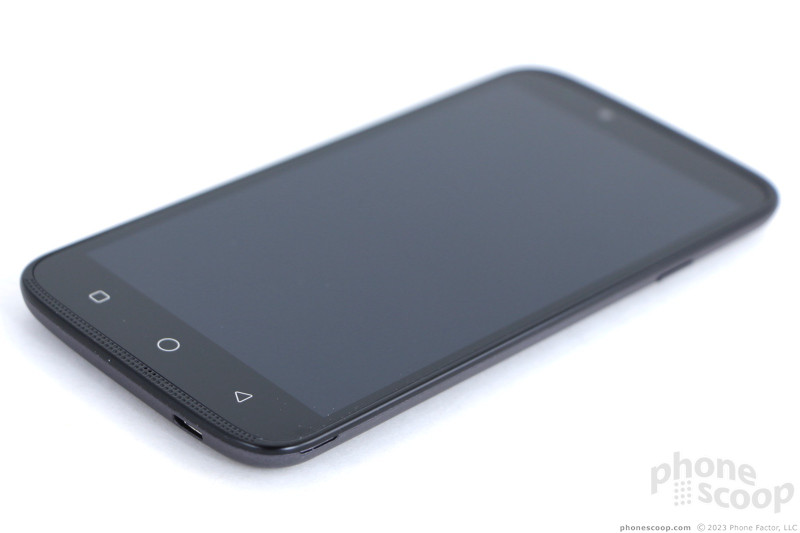


















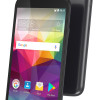 Coolpad Expands Unlocked Lineup with the Splatter
Coolpad Expands Unlocked Lineup with the Splatter
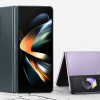 Samsung Refines its Foldable Phones
Samsung Refines its Foldable Phones
 iPhone 14 Plus Offers a Big Screen For Less
iPhone 14 Plus Offers a Big Screen For Less
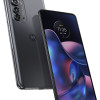 Motorola's new Edge Offers a Lot for $500
Motorola's new Edge Offers a Lot for $500
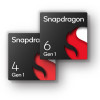 Qualcomm Intros Snapdragon Chips for 2023's Mid-Range & Affordable 5G Phones
Qualcomm Intros Snapdragon Chips for 2023's Mid-Range & Affordable 5G Phones
 Coolpad Canvas / Splatter
Coolpad Canvas / Splatter




